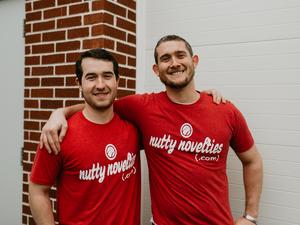
When Jerry Martin invented an inside-out s’more about a decade ago, he never imagined it would one day grow into a lucrative business. But his company Tuck-ins, officially launched in 2017, has grown by a factor of 20 in its first five years and is on track to hit nearly $1 million in sales this year.
The concept is simple. Rather than sandwiching chocolate and marshmallow between graham crackers, Martin decided to place the graham cracker and chocolate inside a marshmallow. The result is a self-contained s’more that’s not as messy as its traditional counterpart.
Martin brought the idea to his now mother-in-law, Carol Levy. Though neither had professional culinary experience, Levy enjoys baking and not only mocked up the company’s first prototype but works on changes to the recipe as needed.
It took years for Martin to move forward with the idea. After speaking with his friend Daniel Zeplowitz, they decided to launch Tuck-ins with Zeplowitz taking on the CEO role. That same year, they had product to market, focusing on special events like holiday markets and street festivals.
“Our sights were pretty narrow in the beginning,” Zeplowitz, a Havertown native and Drexel University grad, recalled. He said they expected to largely sell to Philadelphians, specifically those in Northern Liberties. “Very quickly, we kind of realized that our market was way beyond that.”
Today, Tuck-ins sells in all 50 states through its e-commerce platform and is starting to get inquiries from businesses in Canada. As it looks to tap into other sales avenues, the company is starting to prime the pump for bigger wholesale accounts and is eyeing brands like QVC, Walmart and Giant.
To get to that point, there’s still work to be done, something Zeplowitz and Chief Marketing Officer Maddie Vassallo – who is graduating from Drexel this year before entering an accelerated MBA program – both recognize and are actively working toward.
Presently about 90% of Tuck-ins sales are direct to consumer. Until recently, sales skewed heavily toward the fall and winter months, but the company recently tapped into a new subset of the market through campsites. That’s leading to sales better “evening out throughout the year,” Zeplowitz said.

About 85% of wholesale orders come from campsites, he added.
Tuck-ins come on a wooden stick that can be used for roasting and, when finished, can be tossed onto a bonfire, leaving very little to clean up. “Parents love that,” Zeplowitz said. Tuck-ins can also be roasted over a stove or tabletop roaster.
To land bigger accounts like QVC, the brand needs more scalability as well as some product tweaks that will lengthen shelf life.
Currently Tuck-ins are good for about two weeks, a timeframe that extends to about three months when stored in the freezer. To further increase that, they’re looking at airtight packaging and tweaks to the marshmallow recipe. While Levy works on the recipes, they’ve also tapped food scientists at Rutgers University throughout the development process.
In addition to those changes, Tuck-ins is looking to start its own manufacturing which will allow it to scale. Presently, the products are handmade at the Dorrance H. Hamilton Center for Culinary Enterprises in Philadelphia, which has a commercial commissary kitchen. In total the company has about 35 employees that work there, many of whom are Drexel students.
By owning its manufacturing and lengthening the shelf life, “that will hopefully triple if not quadruple [or more] our production. That's really how we're looking for scale,” Zeplowitz said.
To support that growth, the company is considering raising a Series A funding round of between $500,000 and $750,000 this year. So far, the company has largely been funded by the partners, debt financing and several early friends and family rounds totaling about $65,000.
Tuck-ins are available in three flavors: classic, cookies and cream, and peanut butter. The classic is the best seller, accounting for about 50% of sales, with the remaining 50% evenly split between the other two. The company also sells a seasonal peppermint version and is looking at expanding its product line beyond s’mores.
Franchising may also play into their plans in the future.
Presently the company produces about 4,000 Tuck-ins units a week. In 2021, they produced 125,000 units and $500,000 in sales.
For Zeplowitz and Vassallo, it’s now about enacting their plans to scale.
“If we can make the product, we can sell the product. Because the demand is there,” said Vassallo.
What are some other products you’re exploring?
MV: We are working with a local coffee company to maybe do a Tuck-ins branded coffee. We've been testing some of that. And then also, we feel like we're pretty good in the marshmallow space right now which is kind of a tricky thing. We're also just thinking about other marshmallow-type products that we can venture into with our knowledge.
What might Tuck-ins franchising look like?
DZ: That's something we're excited about that will hopefully [come to fruition in] maybe two to three years. Ideally what that would look like is the model that we operate in Philly, where we're going out and we're setting up at [events]. We want to take that model and bring that to other major cities. Let’s say we're going to Boston – we're thinking that's going to be our first because there's a lot of colleges up there so it's easy to recruit. Ideally, we'll hire a city manager up in Boston. What they would do is they would buy Tuck-ins from us, we would ship it or they'd pick it up, we'd provide the marketing materials, and then they can set up whatever stand or market they want in their city and they can sell it at whatever price. They make their profit that way and then we'll have some sort of agreement for online sales.







